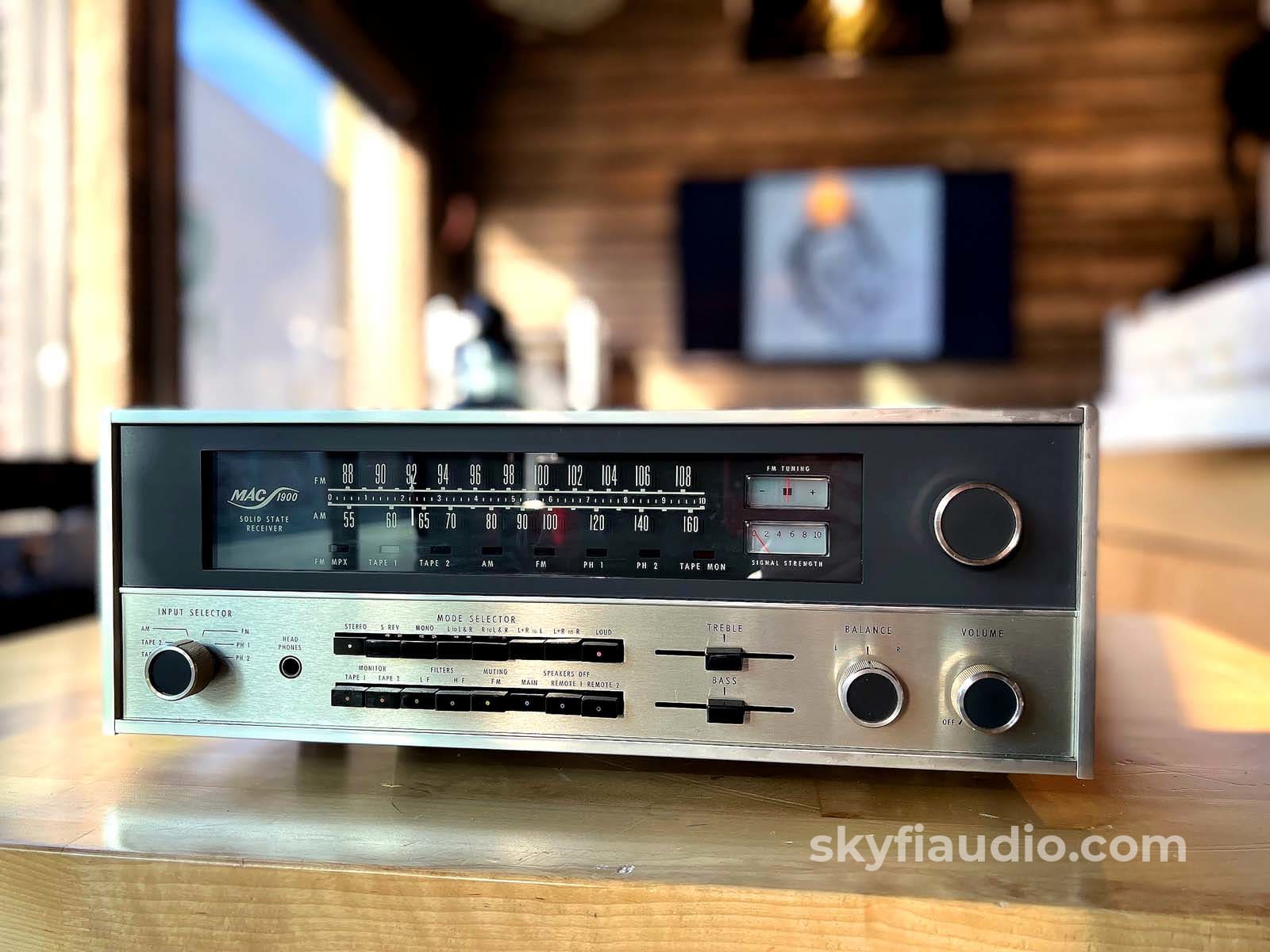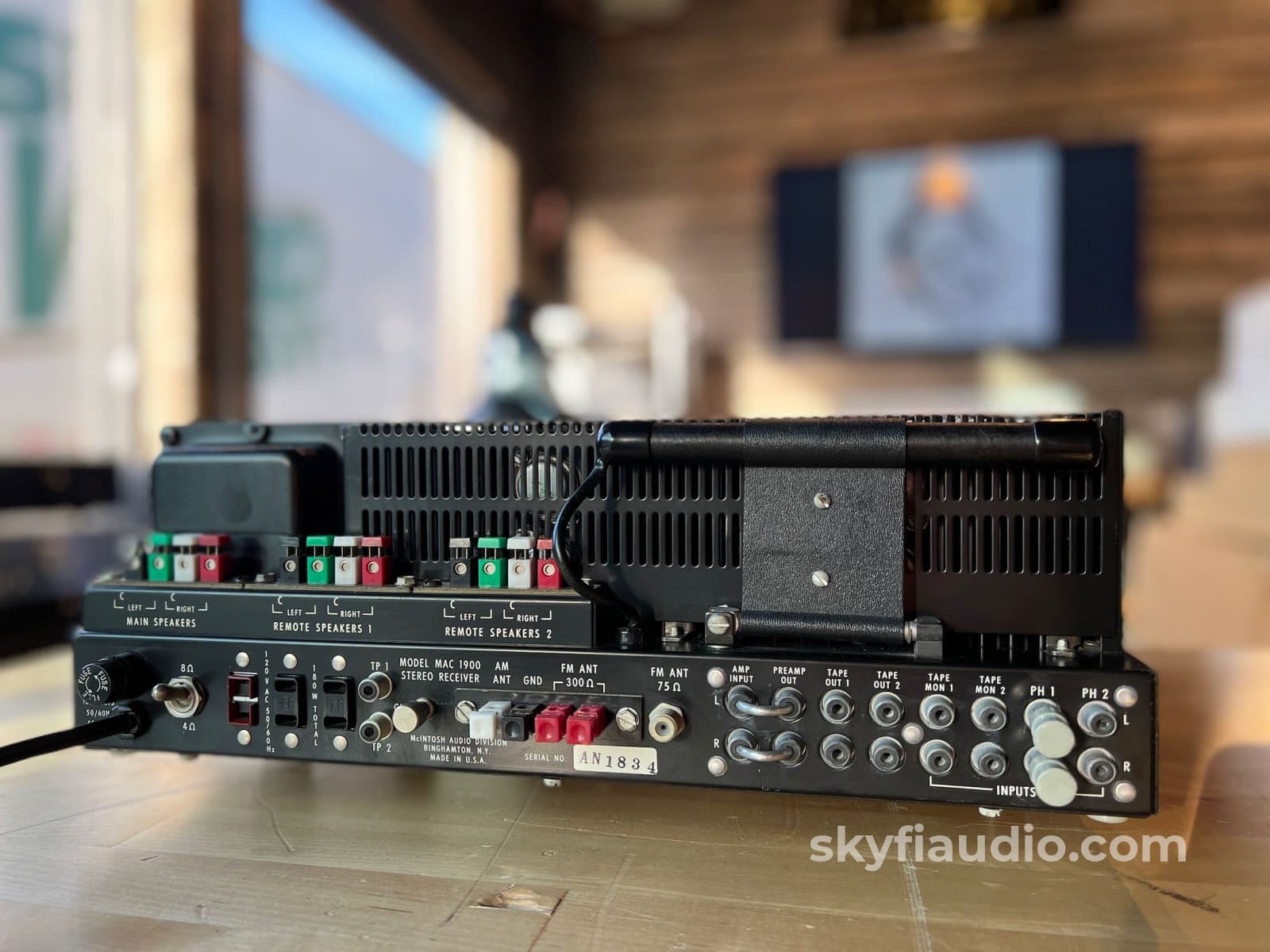










McIntosh MAC1900 The Original High-End Stereo Receiver - Rare Survivor Condition
Free Shipping on *ALL* Electronics (Excluding Speakers, Contiguous 48 US States Only)
Pickup available at SkyFi 479
Usually ready in 24 hours

McIntosh MAC1900 The Original High-End Stereo Receiver - Rare Survivor Condition
SkyFi 479
479 South Broad Street
Glen Rock NJ 07452
United States
This is a super clean classic MAC-1900 in what we call rare survivor condition. This example appears to have all of its original parts installed and intact.
Most MAC-1900's suffer from having spent time in someone's damp basement resulting in light rusting, pitting, and component decay.
Not this one!
The McIntosh MAC-1900 is quickly becoming a great collectible piece, mostly due to its great features, solid tuner section, and amazing looks.
This example received a routine in-house servicing which included securing some broken rivets near the power supply fuses, a thorough cleaning, lamp check, and bench test.
This tested well on our bench clean up to 60W per channel into 8 ohms. AM and FM tuners were checked, and all functions tested and working to McIntosh original spec.
As with all pieces of this age, there are usually some quirks. Aging plastic parts in the switches have caused the stereo button to not engage on occasion. Just a little pressure to the left when pushing helps the button fully engage.
Click below to add our recommended matching cables from Kimber Kable, all brand new as SkyFi is an official Kimber dealer.
Kimber Kable - RCA Interconnects
Kimber Kable - Phono Interconnects
Specifications:
Tuning Ranges:
FM and AM
Power Output:
55 watts per channel into 8Ω (stereo)
Frequency Response:
20 Hz to 20 kHz
Total Harmonic Distortion:
0.2%
Damping Factor:
50
Input Sensitivity:
2 mV (MM), 250 mV (line)
Signal to Noise Ratio:
76 dB (MM), 90 dB (line)
Output:
250 mV (line)
Speaker Load Impedance:
4Ω to 16Ω
Dimensions - W x H x D:
15.99" x 5.51" x 15"
(406 x 140 x 381mm)
Weight:
33 lbs.
(14.97kg)
Finish:
Black and gold anodized front
Years Manufactured:
1972-1975
Original MAC-1900 Owner's Manual
Original MAC-1900 "If You're a Hurry" Guide
The SkyFi Testing Process for Solid State Amplifiers:
We start with a visual inspection of all internal components to make sure that there are no signs of heat stress or damage. Capacitors are checked for telltale signs of predictive failure including bulging, shrunken wrappers, or physical leakage. We also inspect the PCBs for discoloration from resistors or transistors that may have been running hot. On vintage units we often spot check select capacitors for value and ESR.
If the amplifier passes visual inspection, we move on to a controlled power on sequence using a Sencore safety analyzer to monitor current draw in real time. Once the amplifier is determined to be safe to operate, we connect it to full AC mains for function and power testing. We connect the speaker outputs of the amplifier to a Sencore PA81 Power Analyzer which acts as a dummy load, DC offset monitor, and oscilloscope interface. We start with a low level 1KHz test signal at the amplifier’s input and slowly increase its amplitude while monitoring the output on an oscilloscope for signs of noise, clipping, distortion, or improper channel balance. We continue increasing the signal level until the amplifier reaches clipping. At this point we take an output power measurement and compare it to the spec sheet of the amplifier to verify proper performance. If the device under test has both balanced and single ended inputs they are both tested at this time. We finish off the bench evaluation with a 1KHz square wave check and a 20Hz to 20KHz sine sweep to assess the amplifier’s frequency response characteristics. This battery of tests will usually reveal if the amplifier has any issues that need further attention.
Before the device leaves the bench, we perform a listening test with actual music using a variety of preferred test tracks. Our benches are outfitted with familiar monitor speakers which help us identify inconsistencies that will not always show up on our test gear. The main things that we are listening for are hum or noise with no signal present, proper center image, clicks, pops, or any other obvious undesirable audio characteristics.
If the unit passes all of these tests it is moved to our long term testing rig where we simulate real word operating conditions for 6-8 hours. This allows us to monitor the unit for signs of thermal runaway or intermittent issues that only crop up when the unit has fully come up to temperature.
The SkyFi Testing Process for Tuners:
We start with a visual inspection of all internal components to make sure that there are no signs of heat stress or damage. Capacitors are checked for telltale signs of predictive failure including bulging, shrunken wrappers, or physical leakage. We also inspect the PCBs for discoloration from resistors or transistors that may have been running hot. On vintage units we often spot check select capacitors for value and ESR. Vintage analog tuners also have moving parts related to the tuning gang and dial string. These parts are inspected for smooth operation.
If the unit passes visual inspection it is bench tested for a handful of key performance parameters using a Sencore SG80 AM/FM Stereo Analyzer. The SG80 allows us to “simulate” an ideal radio station using precision test signals instead of music. This device, in conjunction with an oscilloscope allows us to properly evaluate the following parameters:
1. AM Reception (Where Applicable)
2. FM Mono Reception & Tuning Meter Function
3. FM MPX Reception (Stereo)
4. Dial Tracking - How accurately the tuner dial or display indicates the actual frequency of the broadcast being received.
5. Stereo Separation - A properly working stereo tuner will have minimal crosstalk between the left and right channel.
6. Sensitivity & Signal Strength Meter Function - By lowering the output of the SG80 we can simulate weak stations and determine how well the tuner will be able to pull in weak distant stations. This adjustment also helps us verify signal strength meter function.
If the tuner has acceptable performance related to the parameters above we connect the unit for listening tests with a simple dipole antenna. We listen for audio reproduction quality of local stations and evaluate how many stations the tuner can receive while we sweep through the dial. We are looking to verify that the tuner can decode stereo on strong local broadcasts and pick up a wide variety of local stations at the bottom, middle, and top of the frequency band. At this point we also test convenience features such as muting, filters, built in oscilloscope function, etc.
We finish up with an extended listening test on our long term test rig. We tune in a strong local station and monitor for drift over a 2-3 hour period.
|
Item |
Included |
|
Original Box |
Not Included |
|
Manual |
Online Only |
|
Remote |
Not Applicable |
|
Cables |
Yes - Power Only |
|
Physical Condition |
8 / 10 |
|
Working Condition |
10 / 10 |
Choose options











